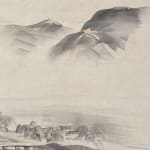




Nikka Tanaka
Daimonji - Mountain with Bonfire, ca.1820
Sumi ink and color on paper
silk mounting
silk mounting
13 1/4 “ X 18 1/2” ; scroll, 45” X 19 1/4”
Further images
Daimonji (大文字) is one of the iconic festivals of Kyoto. Although it only lasts 30 minutes, it is the center of the O- Bon festival held each year on August...
Daimonji (大文字) is one of the iconic festivals of Kyoto. Although it only lasts 30 minutes, it is the center of the O- Bon festival held each year on August 16, during which the townspeople lit five giant bonfires on mountains surrounding the city. It is a common belief that our ancestors' spirits visit our houses and the town during O-Bon. The five bonfires are the festival's finale so that they can go back to their spiritual world safely. The first fire to be lit is built in the shape of the kanji character Dai (大), which means "big." In the painting, it is depicted in red near the top of the work. At the bottom of the work represents the town where the spirits' mortal relatives live.
Daimonji is one of the most popular subjects in Japanese painting. Thus it has been the object of much competition among artists. This Nikka's work is an excellent one. His masterful brushstrokes tell the summer heat, the excitement of the festival, and the inner quietness of those who are sending off spirits. The middle of the painting, which is left blank, is filled with contemplation, reflection, and meditation.
About the Artist
One of the pupils of Toyohiko, the Shijo school painter, Tanaka, Nikka was active in the first part of the 19th century and is recognized as one of the significant artists of the Shijo school. He died in 1845, and though his birth date is not known, his work was highly regarded during his lifetime. His work was first recorded in 1815 in Kyoto, and his name is also mentioned in, Bunsei no koro no Monjo (Cultural Matters Heard in Bunsei era), a magazine published during the Bunsei era (1818 - 1829). During this time in Kyoto, Keibun and Toyohiko were considered the two most celebrated painters. Nikka has excellent brushwork, which was swift, elegant, and masterful. In his book, The Uninhibited Brush, Jack Hillier writes, "there are qualities in the painting of Tanaka Nikka that almost lift him on the highest plane ... "
Daimonji is one of the most popular subjects in Japanese painting. Thus it has been the object of much competition among artists. This Nikka's work is an excellent one. His masterful brushstrokes tell the summer heat, the excitement of the festival, and the inner quietness of those who are sending off spirits. The middle of the painting, which is left blank, is filled with contemplation, reflection, and meditation.
About the Artist
One of the pupils of Toyohiko, the Shijo school painter, Tanaka, Nikka was active in the first part of the 19th century and is recognized as one of the significant artists of the Shijo school. He died in 1845, and though his birth date is not known, his work was highly regarded during his lifetime. His work was first recorded in 1815 in Kyoto, and his name is also mentioned in, Bunsei no koro no Monjo (Cultural Matters Heard in Bunsei era), a magazine published during the Bunsei era (1818 - 1829). During this time in Kyoto, Keibun and Toyohiko were considered the two most celebrated painters. Nikka has excellent brushwork, which was swift, elegant, and masterful. In his book, The Uninhibited Brush, Jack Hillier writes, "there are qualities in the painting of Tanaka Nikka that almost lift him on the highest plane ... "
Signup for our Newsletter
You will receive two emails a month from us. One introduces artworks and design works from Kyoto's hidden sources and the other is stories from Misako, sharing insights into Japanese culture.
* denotes required fields
为了回应您的查询,我们将根据我们的隐私政策处理您提供的个人数据。




